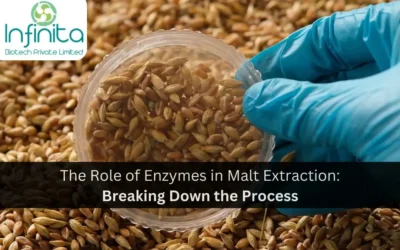Water quality plays a crucial role in the brewing process, particularly when it comes to malt extraction. Understanding the importance of water quality and its impact on the brewing process can help brewers achieve consistent and high-quality results. In this article, we will explore the science behind malt extraction, the role of water in the brewing process, and the consequences of poor water quality. We will also discuss techniques for improving water quality and future perspectives on water quality management in the brewing industry.
Understanding the Importance of Water Quality in Brewing
Water is the primary ingredient in beer production and acts as a solvent, extracting sugars and other compounds from the malt. It also affects the enzymatic activity during mashing, influences hop utilization, and can even impact the flavor and aroma of the final product. Therefore, it is crucial for brewers to pay close attention to the quality of the water used in their brewing process.
The Role of Water in the Brewing Process
Water serves as the foundation for the mashing process, where enzymes in the malt convert starches into fermentable sugars. It also helps to create the desired pH level during mashing and provides the necessary minerals and nutrients that yeast requires for fermentation. Furthermore, water quality affects the extraction of flavors from hops, influencing the bitterness and aroma of the beer.
Moreover, the temperature of the water used in brewing is a critical factor to consider. Different stages of the brewing process, such as mashing, lautering, boiling, and cooling, require specific water temperatures to achieve optimal results. For example, mashing typically occurs at temperatures ranging from 140°F to 158°F, depending on the desired outcome for the beer being brewed. Maintaining precise water temperatures throughout the brewing process is essential for achieving consistency and quality in the final product.
Key Elements of Water Quality
When assessing water quality for brewing purposes, brewers look at various factors such as pH level, mineral content, hardness, and overall purity. Ideally, the pH of brewing water should be in the range of 5.2 to 5.6, as this supports enzyme activity during mashing. The mineral content, particularly calcium and magnesium, plays a critical role in yeast health and fermentation. The level of hardness influences the efficiency of the mashing process and affects the overall flavor profile of the beer.
Additionally, the presence of chlorine or chloramine in brewing water can have detrimental effects on the fermentation process and lead to off-flavors in the finished beer. Brewers often use water treatment methods such as carbon filtration, reverse osmosis, or Campden tablets to remove chlorine and chloramine from the water before brewing. By ensuring that the brewing water is free from these compounds, brewers can maintain the integrity of the beer’s flavor profile and achieve the desired characteristics in the final product.
The Science Behind Malt Extraction
Malt extraction is the process of converting the starches in malted barley into fermentable sugars, which are then consumed by yeast during fermentation. Understanding the science behind malt extraction is essential for brewers to optimize this process and produce high-quality beers.
Delving deeper into the intricacies of malt extraction reveals a fascinating interplay of enzymes, temperature, and chemistry that ultimately shape the flavor profile of the beer. Beyond the basic conversion of starches to sugars, the process involves a delicate balance of enzymatic activity and temperature control to achieve the desired outcome.
What is Malt Extraction?
Malt extraction involves breaking down the starches in malted barley using enzymes naturally present in the grain, namely alpha-amylase and beta-amylase. These enzymes break the starches into smaller sugar molecules, mainly maltose. The resulting sugar solution, known as wort, is then fermented by yeast to produce alcohol and CO2, giving the beer its characteristic flavor and carbonation.
Furthermore, the malt extraction process is not only about sugar production but also about extracting a myriad of flavor compounds that contribute to the complexity of the final brew. The interaction between enzymes and substrates during mashing plays a crucial role in releasing aromatic compounds, phenols, and other flavor precursors that shape the sensory experience of the beer.
The Chemistry of Malt Extraction
The enzymes responsible for malt extraction are temperature-sensitive, with each enzyme having an optimal temperature range for activity. Alpha-amylase, which breaks down long starch chains into shorter dextrins, is active at temperatures between 154°F and 162°F (68°C and 72°C). Beta-amylase, responsible for further breaking down dextrins into fermentable sugars, is active at temperatures between 140°F and 150°F (60°C and 65°C). Maintaining the correct temperature during mashing is crucial to maximize enzymatic activity and promote efficient malt extraction.
Moreover, the chemistry behind malt extraction extends beyond enzymatic reactions to include pH levels, water chemistry, and the composition of the malt itself. Factors such as mash thickness, water-to-grist ratio, and the use of adjuncts can influence the efficiency of sugar extraction and the overall quality of the beer. By understanding the intricate interplay of these variables, brewers can fine-tune their processes to achieve consistency and excellence in their brews.
The Impact of Water Quality on Malt Extraction
The quality of water used in the brewing process can significantly impact malt extraction and, consequently, the overall quality of the beer. Different water qualities can affect enzyme activity, pH levels, mineral availability, and the extraction of desirable compounds.
Water is a crucial ingredient in the brewing process, constituting more than 90% of beer’s composition. It not only serves as a solvent for extracting sugars, proteins, and other compounds from the malt but also plays a key role in enzymatic reactions that break down complex molecules into fermentable sugars. The interaction between water and malt is a delicate dance that can be influenced by various factors, making water quality a critical consideration for brewers seeking consistent and high-quality results.
How Different Water Qualities Influence Malt Extraction
The composition of water, particularly its mineral content, can affect the activity of enzymes during mashing. Hard water, which contains high levels of calcium and magnesium, can enhance enzymatic activity and improve malt extraction. On the other hand, soft water can result in lower enzyme activity and poor starch conversion. The pH level of the water also affects enzymatic activity and overall malt extraction efficiency. Water with a pH outside the optimal range can inhibit enzyme function and adversely affect the brewing process.
Furthermore, the presence of certain ions in water, such as sulfate and chloride, can impact the perception of bitterness and mouthfeel in beer. Sulfate ions tend to accentuate hop bitterness, making the beer taste drier and more crisp, while chloride ions can enhance the perception of sweetness and fullness in the mouthfeel. Brewers often tailor their water profiles to achieve specific flavor profiles in their beers, adjusting mineral levels to complement the desired characteristics of the final product.
The Consequences of Poor Water Quality
Poor water quality can lead to inefficient extraction of sugars from the malt, resulting in lower alcohol content and a less desirable flavor profile. It can also impact yeast health and fermentation, leading to stuck fermentations, off-flavors, and other fermentation issues. Additionally, high levels of minerals or contaminants in the water can contribute to off-flavors and haze in the finished beer.
Ensuring consistent and suitable water quality is essential for brewers aiming to produce high-quality beer. Water treatment methods such as filtration, reverse osmosis, and mineral adjustments can help mitigate the negative effects of poor water quality, allowing brewers to create beers that showcase the desired flavors, aromas, and mouthfeel characteristics.
Improving Water Quality for Optimal Malt Extraction
Brewers have several techniques at their disposal to improve the quality of water used in the brewing process. By implementing these techniques, brewers can enhance malt extraction efficiency and produce beers with consistent quality and flavor profiles.
Techniques for Water Quality Improvement
Methods such as reverse osmosis, activated carbon filtration, and ion exchange can help remove impurities, adjust mineral content, and achieve the desired water profile for brewing. Additionally, water treatment additives, such as gypsum or calcium chloride, can be used to modify water chemistry and create the optimal environment for enzyme activity during mashing.
Maintaining Consistent Water Quality for Brewing
Regular water testing and monitoring are crucial for maintaining consistent water quality in the brewing process. Brewers should track pH levels, mineral content, and any potential contaminants to ensure that water quality remains within the desired parameters. Establishing a water treatment plan and implementing regular maintenance protocols for water treatment equipment are also essential.
Future Perspectives on Water Quality and Malt Extraction
As the brewing industry continues to evolve, so does our understanding of water quality management and its impact on malt extraction. To meet the increasing demand for unique and high-quality craft beers, brewers are exploring innovative approaches to water treatment and incorporating advanced technologies.
Innovations in Water Quality Management
New methods, such as advanced filtration techniques and alternative water sources, are being developed to improve water quality and provide brewers with more control over their brewing process. Additionally, advancements in water analysis tools and software allow brewers to monitor and adjust water quality parameters more accurately.
The Future of Malt Extraction in Brewing
As brewers gain a deeper understanding of the intricate relationship between water quality and malt extraction, they can implement more refined techniques to achieve consistent results. The future holds exciting possibilities for the brewing industry, as brewers continue to explore ways to optimize water quality and malt extraction to create unique and exceptional beers.
In conclusion, water quality has a significant impact on malt extraction and, ultimately, the quality and flavor of beer. Understanding the role of water in the brewing process, the science behind malt extraction, and the consequences of poor water quality is essential for brewers aiming to produce consistent and high-quality beers. By improving water quality and implementing effective water treatment techniques, brewers can optimize malt extraction and create beers that showcase the best characteristics of their ingredients.







